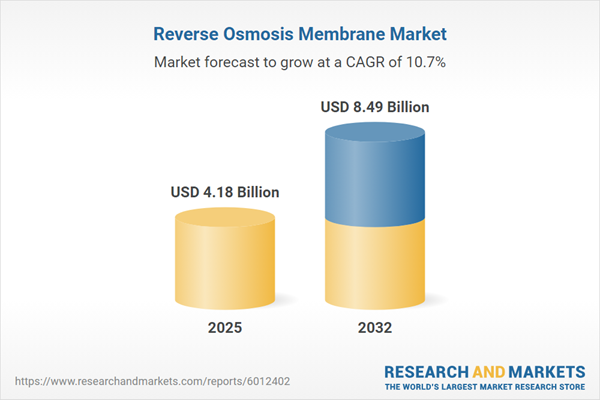Speak directly to the analyst to clarify any post sales queries you may have.
A strategic approach to advanced water treatment is rapidly transforming the competitive landscape for senior decision-makers navigating operational risk and regulatory compliance. As organizations prioritize sustainable growth and dependable water management, the reverse osmosis membrane market is emerging as a key platform for aligning technology investments with core business outcomes.
Market Snapshot: Reverse Osmosis Membrane Market Growth and Outlook
The global reverse osmosis membrane market is witnessing robust expansion, driven by shifting regulatory standards, increased investments in water treatment infrastructure, and adoption across diverse sectors. Revenues are projected to accelerate from USD 3.77 billion in 2024 to USD 4.18 billion in 2025, reaching USD 8.49 billion by 2032, supported by a 10.67% CAGR. This growth extends across industrial, municipal, and residential segments as adoption of innovative membrane solutions intensifies. Procurement executives are responding to intensified water quality regulations and prioritizing platforms that enable long-term compliance and resilience. The emphasis on water quality management and operational efficiency has become integral to acquisition strategies, particularly in regions with evolving regulatory demands.
Scope & Segmentation: Strategic Insights on the Reverse Osmosis Membrane Market
This market research report provides decision-ready insights for executives tasked with procurement, supply chain optimization, and capital allocation within the reverse osmosis membrane industry. The scope addresses key segmentation dimensions to align technology selection and investment decisions with compliance and operational priorities.
- Module Design: Offers analysis of hollow fiber and spiral wound modules, facilitating adaptation to diverse infrastructure and spatial requirements in water treatment projects.
- Membrane Type: Examines cellulose triacetate and polyamide thin-film composite membranes, tailored for sector-specific regulatory and filtration efficiency objectives.
- Operating Pressure: Assesses the suitability of low-pressure and high-pressure systems, supporting robust equipment selection for centralized and decentralized applications.
- Application: Provides guidance on deployment across food service, hospitality, municipal, desalination, industrial processing, and residential sectors, incorporating regulatory and practical use-case considerations.
- End Use Industry: Profiles adoption and compliance requirements within food and beverage, pharmaceuticals, and power generation industries, focusing on reliability attributes vital to each vertical.
- Regional Coverage: Analyzes market dynamics across the Americas, Europe, Middle East, Africa, and Asia-Pacific, with insights on regulatory trends, market entry, and supply chain adaptation for established and developing regions.
- Company Development Highlights: Details recent product launches, strategic collaborations, and capacity enhancements shaping market competition and influencing procurement decisions.
By understanding these segmentation factors, organizations can shape sourcing and investment strategies, mitigate risks linked to regulatory diversity, and strengthen their water treatment ecosystem against market shifts and supply disruptions.
Key Takeaways for Strategic Decision-Makers
- Advances in membrane materials and system architectures enhance asset durability while increasing flexibility to meet operational change.
- Implementing digital monitoring and management improves visibility, enabling real-time process adjustments for more reliable water quality.
- Modular system options allow seamless transitions between different treatment models, supporting agile responses to evolving site requirements.
- Growing regional investments in supply chains and sourcing strategies fortify the ability to meet new compliance mandates and secure consistent water supply.
- Innovation in materials and operational efficiency supports broader corporate sustainability objectives while limiting environmental and supply chain vulnerabilities.
Tariff Impact: Navigating New U.S. Trade Measures
Newly introduced U.S. tariffs on reverse osmosis membrane components and finished goods are prompting importers to reconsider supplier relationships and adjust procurement frameworks. The shift toward regional sourcing and adoption of flexible procurement approaches is enhancing supply chain stability and creating new market opportunities for domestic industry stakeholders as organizations adapt to updated trade regulations.
Methodology & Data Sources
Findings are derived from comprehensive secondary research, expert interviews, and dynamic panel sessions. Each data point is cross-validated using trade statistics, real-time shipment analysis, and proprietary procurement intelligence to ensure actionable, executive-grade insight.
Why This Reverse Osmosis Membrane Market Report Matters
- Enables organizations to refine capital planning and react swiftly to regulatory and supply chain fluctuations within the water treatment sector.
- Equips leaders with current benchmarks and fact-based insights, building the confidence needed for effective, compliance-focused decisions.
- Provides practical frameworks for addressing risk and leveraging emerging opportunities as new technologies and regional dynamics reshape water filtration markets.
Conclusion
This analysis empowers executive teams to guide strategic planning based on reliable market intelligence. Leveraging these insights supports regulatory alignment, operational resilience, and confident investment strategies in the changing water treatment landscape.
Additional Product Information:
- Purchase of this report includes 1 year online access with quarterly updates.
- This report can be updated on request. Please contact our Customer Experience team using the Ask a Question widget on our website.
Table of Contents
3. Executive Summary
4. Market Overview
7. Cumulative Impact of Artificial Intelligence 2025
Companies Mentioned
The companies profiled in this Reverse Osmosis Membrane market report include:- E.I. du Pont de Nemours and Company
- The Dow Chemical Company
- Toray Industries, Inc.
- Nitto Denko Corporation
- LG Chem, Ltd.
- SUEZ S.A.
- Koch Industries, Inc.
- Evonik Industries AG
- Toyobo Co., Ltd.
- Mitsubishi Chemical Corporation
Table Information
| Report Attribute | Details |
|---|---|
| No. of Pages | 198 |
| Published | November 2025 |
| Forecast Period | 2025 - 2032 |
| Estimated Market Value ( USD | $ 4.18 Billion |
| Forecasted Market Value ( USD | $ 8.49 Billion |
| Compound Annual Growth Rate | 10.6% |
| Regions Covered | Global |
| No. of Companies Mentioned | 11 |









